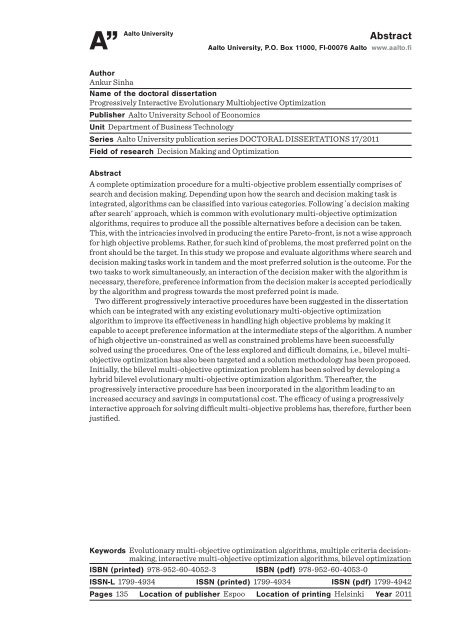Progressively Interactive Evolutionary Multi-Objective Optimization ...
Progressively Interactive Evolutionary Multi-Objective Optimization ...
Progressively Interactive Evolutionary Multi-Objective Optimization ...
Create successful ePaper yourself
Turn your PDF publications into a flip-book with our unique Google optimized e-Paper software.
Abstract<br />
Aalto University, P.O. Box 11000, FI-00076 Aalto www.aalto.fi<br />
Author<br />
Ankur Sinha<br />
Name of the doctoral dissertation<br />
<strong>Progressively</strong> <strong>Interactive</strong> <strong>Evolutionary</strong> <strong>Multi</strong>objective <strong>Optimization</strong><br />
Publisher Aalto University School of Economics<br />
Unit Department of Business Technology<br />
Series Aalto University publication series DOCTORAL DISSERTATIONS 17/2011<br />
Field of research Decision Making and <strong>Optimization</strong><br />
Abstract<br />
A complete optimization procedure for a multi-objective problem essentially comprises of<br />
search and decision making. Depending upon how the search and decision making task is<br />
integrated, algorithms can be classified into various categories. Following `a decision making<br />
after search' approach, which is common with evolutionary multi-objective optimization<br />
algorithms, requires to produce all the possible alternatives before a decision can be taken.<br />
This, with the intricacies involved in producing the entire Pareto-front, is not a wise approach<br />
for high objective problems. Rather, for such kind of problems, the most preferred point on the<br />
front should be the target. In this study we propose and evaluate algorithms where search and<br />
decision making tasks work in tandem and the most preferred solution is the outcome. For the<br />
two tasks to work simultaneously, an interaction of the decision maker with the algorithm is<br />
necessary, therefore, preference information from the decision maker is accepted periodically<br />
by the algorithm and progress towards the most preferred point is made.<br />
Two different progressively interactive procedures have been suggested in the dissertation<br />
which can be integrated with any existing evolutionary multi-objective optimization<br />
algorithm to improve its effectiveness in handling high objective problems by making it<br />
capable to accept preference information at the intermediate steps of the algorithm. A number<br />
of high objective un-constrained as well as constrained problems have been successfully<br />
solved using the procedures. One of the less explored and difficult domains, i.e., bilevel multiobjective<br />
optimization has also been targeted and a solution methodology has been proposed.<br />
Initially, the bilevel multi-objective optimization problem has been solved by developing a<br />
hybrid bilevel evolutionary multi-objective optimization algorithm. Thereafter, the<br />
progressively interactive procedure has been incorporated in the algorithm leading to an<br />
increased accuracy and savings in computational cost. The efficacy of using a progressively<br />
interactive approach for solving difficult multi-objective problems has, therefore, further been<br />
justified.<br />
Keywords <strong>Evolutionary</strong> multi-objective optimization algorithms, multiple criteria decisionmaking,<br />
interactive multi-objective optimization algorithms, bilevel optimization<br />
ISBN (printed) 978-952-60-4052-3 ISBN (pdf) 978-952-60-4053-0<br />
ISSN-L 1799-4934 ISSN (printed) 1799-4934 ISSN (pdf) 1799-4942<br />
Pages 135 Location of publisher Espoo Location of printing Helsinki Year 2011
















